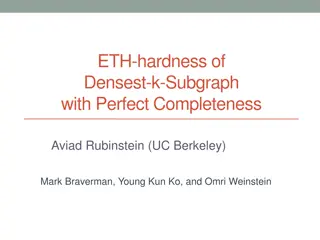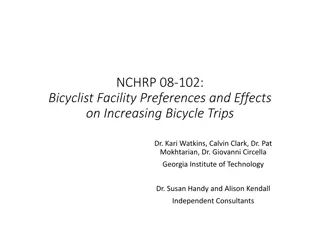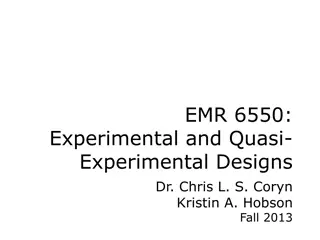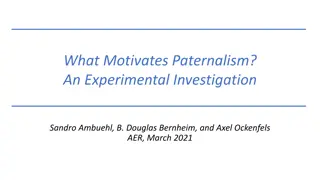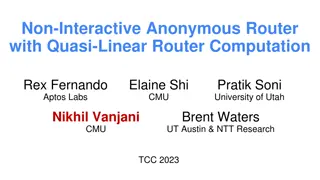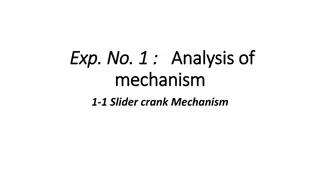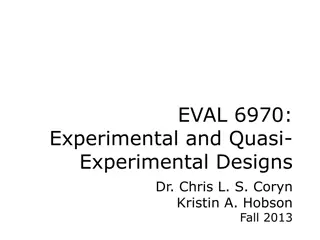Understanding Nonexperimental and Quasi-experimental Studies
Nonexperimental and quasi-experimental studies resemble experiments but lack random assignment, making them valuable for group comparisons without establishing causation. This type of research design looks at differences between groups that already exist, focusing on group differences rather than cause and effect relationships. Examples include quasi-experimental designs, between-subjects designs, and pre-post designs. Such studies compare groups under different conditions without attempting to control variables. Explore the characteristics and applications of nonexperimental and quasi-experimental studies in research.
Download Presentation

Please find below an Image/Link to download the presentation.
The content on the website is provided AS IS for your information and personal use only. It may not be sold, licensed, or shared on other websites without obtaining consent from the author. Download presentation by click this link. If you encounter any issues during the download, it is possible that the publisher has removed the file from their server.
E N D
Presentation Transcript
Nonexperimental and quasi-experimental studies often look like experiments in terms of the general structure of the research study since they all compare groups under treated different conditions. /35 2
A quasi-experimental design is one that looks like an experimental design but lacks the key ingredient -- random assignment. Uses Intact groups Two high schools treated differently /35 3
Non-experimental research compares groups but does not attempt to explain the cause and effect relationship. /35 4
Between-subjects designs, also known as nonequivalent group designs Within-subjects designs, also known as pre post designs 1. 2. /35 5
Researcher cannot control variables or conditions that makes the two groups equivalent. /35 6
( 1) the differential research design. (Non) ( 2) the posttest- only non-equivalent control group design. (Non) ( 3) the pretest posttest nonequivalent control group design. (Quasi) /35 7
Group differences are the primary interest not the cause an effect. Studies pre-existing groups No treatment This type of study often is called ex post facto research because it looks at differences after the fact; that is, at differences that already exist between groups. /35 8
Age differences Gender differences Difference between CSULB and CSULA students in their Math scores. Compare academic performance of 2 groups of high and low self esteem /35 9
This type of study is occasionally called a static group comparison. Compares treatment with no-treatment group /35 10
Example, Difference between those who take a course and those who don t. Comparing 2 high schools one with a pregnancy prevention program and one without Comparing two classes after they were taught with 2 different teaching methods. /35 11
A much stronger version of the nonequivalent control group design is often called a pretest posttest nonequivalent control group design and can be represented as follows: The addition of the pretest measurement allows researchers to address the problem of assignment bias that exists with all nonequivalent group research. /35 12
Although the addition of a pretest to the nonequivalent control group design reduces some threats to internal validity, it does not eliminate them completely. Example, Groups are equal in their pretest but not in their IQ /35 13
A series of observations is made over time. Collectively, such studies are known as pre post designs. /35 14
One- group pretest posttest design (Non) Time- series design (Quasi) /35 15
the five categories of time- related threats are history, instrumentation, testing effects, maturation, and statistical regression can threaten internal validity. /35 16
Because the one- group pretest posttest study precludes a cause- and- effect conclusion, this type of research is classified as non-experimental. example, political advertisement May October /35 17
Chart Title 80% 70% 60% 50% 40% 30% 20% 10% 0% Before Summer After /35 18
A time- series design requires a series of observations for each participant before and after a treatment or event. Thus, the series of observations allows a researcher to minimize most threats to internal validity. As a result, the time- series design is classified as quasi- experimental. /35 19
It is possible for an external event ( history) to be a threat to internal validity EVEN in time- series designs, but only if the event occurs simultaneously with the treatment. /35 20
/35 21
Research designs that focus on a single case, rather than a group of participants, are occasionally called single-case time-series designs but are more often classified as single- subject or single- case designs. /35 22
/35 23
Two basic types of developmental research designs are the cross- sectional design and the longitudinal design. /35 24
/35 25
The cross- sectional developmental research design uses different age groups of individuals. The different groups are measured at one point in time and then compared. /35 26
One obvious advantage of the cross- sectional design is that a researcher can observe how behavior changes as people age without waiting for a group of participants to grow older. Saves cost of follow up /35 27
A researcher cannot say anything about how a particular individual develops over time because individuals are not followed over years. /35 28
Elementary High School College Example 1, drugs legalization Example 2, computer games /35 29
The longitudinal developmental research design examines development by observing or measuring a group of subjects over time. /35 30
A major strength of the longitudinal research design is the absence of cohort effects because the researcher examines one group of people over time rather than comparing groups that represent different ages and come from different generations. Second, with longitudinal research, a researcher can discuss how a single individual s behavior changes with age. /35 31
1-longitudinal research is extremely time consuming, both for the participants ( it requires a big commitment to continue in the study) and the researcher. /35 32
2- In addition, these designs are very expensive 3- These designs are subject to high dropout rates of participants. and it may weaken the internal validity of the research. 4- Testing effects (the same individuals are measured repeatedly). /35 33
Compare the results obtained from separate samples at different times. typically, this type of research is examining the development of phenomena other than individual aging. this research combines elements of cross- sectional and longitudinal designs. /35 34
1970 1990 2010 /35 35











